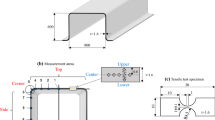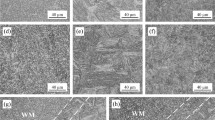Abstract
We study the susceptibility of a welded joint of 17G1S steel to hydrogen embrittlement depending on the sequence of application of hydrogenation and loading. The highly plastic welded joint is susceptible to hydrogen embrittlement under rapid active loading performed after preliminary electrolytic hydrogenation (PEH) in acid solutions only in the presence of stimulants and high current densities. The highest susceptibility to hydrogen embrittlement is exhibited by the base metal and the zone of thermal influence. The PEH of loaded specimens increases the susceptibility of the welded joint to hydrogen embrittlement. Moreover, the higher the stress, the more pronounced the indicated effect. The procedure of plastic prestraining of the welded joint increases its susceptibility to hydrogen embrittlement after PEH. The effect of hydrogen embrittlement after PEH is more pronounced for more intense plastic prestraining but weaker than in the case of hydrogenation in the process of active loading, i.e., under the combined action of stresses and strains.
Similar content being viewed by others
REFERENCES
I. I. Vasylenko, O. Yu. Shul’te, and O. I. Radkevych, “Influence of the chemical composition and technology of production of steels on their susceptibility to hydrogen and hydrogen-sulfide cracking,” Fiz.-Khim. Mekh. Mater., 35, No.4, 8–22 (1999).
V. D. Makarenko, V. A. Petrovskii, and V. Yu. Chernov, “Mechanism of hydrogen-induced stratification of pipe steels of oil-and-gas pipelines,” Fiz.-Khim. Mekh. Mater., 39, No.6, 111–114 (2003).
O. I. Radkevych, “Influence of the chemical composition of welded joints of pipelines on the crack-growth resistance in hydrogen-sulfide media,” Fiz.-Khim. Mekh. Mater., 35, No.1, 95–102 (1999).
V. D. Makarenko, S. I. Grachev, V. Yu. Chernov, et al., Welding and Corrosion of Oil-and-Gas Pipelines in West Siberia [in Russian], Naukova Dumka, Kiev (1996).
E. I. Kryzhanivs’kyi, O. T. Tsyrul’nyk, and D. Yu. Petryna, “Influence of hydrogenation and plastic prestraining of steel on its crack resistance,” Fiz.-Khim. Mekh. Mater., 35, No.5, 67–70 (1999).
H. G. Nelson, “Hydrogen Embrittlement,” in: C. L. Briant and S. K. Banerji (editors), Embrittlement of Engineering Alloys [Russian translation], Metallurgiya, Moscow (1988), pp. 256–333.
European Structural Integrity Society. ESIS Recommendations for Stress Corrosion Testing Using Precracked Specimens: ESIS P4-92 D, ESIS, Delft (1992).
Author information
Authors and Affiliations
Additional information
__________
Translated from Fizyko-Khimichna Mekhanika Materialiv, Vol. 40, No. 6, pp. 111–114, November–December, 2004.
Rights and permissions
About this article
Cite this article
Tsyrul’nyk, O.T., Kryzhanivs’kyi, E.I., Petryna, D.Y. et al. Susceptibility of a Welded Joint of 17G1s Steel in a Gas Main to Hydrogen Embrittlement. Mater Sci 40, 844–849 (2004). https://doi.org/10.1007/s11003-005-0123-9
Received:
Published:
Issue Date:
DOI: https://doi.org/10.1007/s11003-005-0123-9




